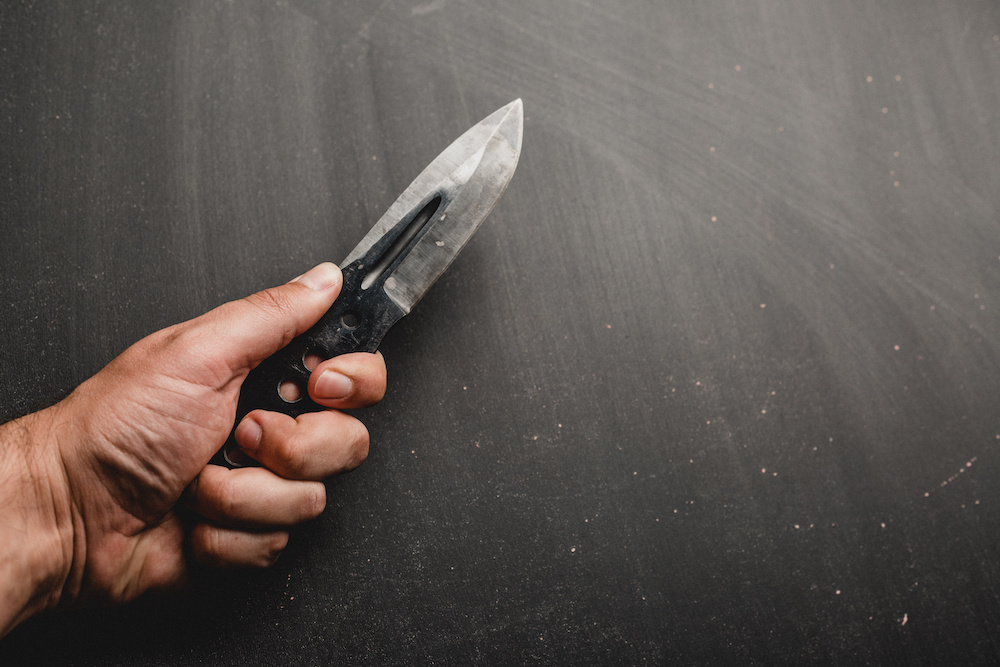Signup for our monthly newsletter and get your FREE "Tactical Gear" Guide
How To Throw a Tactical Knife: A Guide for Beginners
- Home
- Tactical Knife Advice
- How To Throw a Tactical Knife

This site contains affiliate links to products. We may receive a commission for purchases made through these links.
In many martial arts videos, the artists are graceful and flowy in their use of a bladed weapon.
However, not everyone can attend an in-person bladed martial arts class. It can be due to time constraints or simple financial inability.
Has it occurred to you that you can practice your own form of martial arts throwing at home?
If you’ve always wanted to learn how to throw a tactical knife, you can start practicing now.
Table of Contents
Where It All Began
The art of knife throwing is more than just the act of flinging a blade at a random object.
Rather, it is an age-old art form, a sport, a combat skill, and a form of lively entertainment.
Knife throwing is a popular hobby dating back to prehistoric times and is practiced all over the world.
It is an art form whose traces lead to ancient Egypt, Japan, and Africa.
Nowadays, knife throwing is a celebrated sport that has spawned many competitions worldwide.
In fact, it came to the point that knife throwing was such a competitive sport that they formed the American Knife Throwing Alliance.
The Perks of Knife Throwing
Alongside its fairly rich history, knife throwing is an art form.
Much like other martial art practices, such as archery or fencing, throwing knives is a good means of exercise.
While it is not a practice that will get you out of breath, the skill required to aim, balance, and throw your knife demands your utmost attention.
It is fun in the same way that throwing darts or playing pool can be when you’ve gotten the basics down.
This way, you can focus on the act itself while letting off some steam in the meantime.
It should be noted that while knife throwing is an individual sport, it is by no means solitary.
Rather, by picking up this sport, there’s no doubt you will find other like-minded individuals just as interested in this newfound hobby.
There are plenty of competitions and gatherings you can join in, and if the crowds are too much, you can host a simple get-together at home.
Teach your friends how to throw, and you’ve got a new bonding moment at hand.
How To Throw a Tactical Knife
Before anything else, you will want to ensure you are wearing the protective tactical clothing and is in a safe area.
A balanced throwing knife can come in the form of a bowie knife, combat knife, a survival knife, an assortment of junk knives, and even butter knives.
Here’s what you need to know when learning how to throw a tactical knife:
Throwing Style
The two most common forms of knife throwing are rotational throwing and no-spin throwing.
Rotational throwing is a technique wherein the knife rotates end-over-end during its trajectory.
For this method, the knife is held by either the handle or the blade. That said, it should be noted that this style is not very beginner-friendly.
On the other hand, no-spin throwing is any technique wherein the knife does not spin or rotate during its trajectory.
In this instance, the knife is always held by the handle. Because of this, it is an easier method for beginners and is what we will be talking about in this article.

Thorn, Russian, Traditional Japanese, and Contemporary Japanese
The four primary sub-styles of no-spin throwing are Thorn, Russian, Traditional Japanese, and Mumyou-Rou (contemporary Japanese).
- Thorn
Thorn is a method created by Ralph Thorn in the late 1990s. It is best done with larger knives 10 to 15 inches in length.
This technique is simple and utilizes an easy windmill-like arm motion, a drive-finger grip, and a sliding release.
The drive-finger grip is when the knife is held between the thumb and middle finger while the index finger rests on the knife’s spine.
- Russian
Russian knife throwing was pioneered by Nail Ahmadu and Yuri Fedin. It is a method that utilizes medium-sized knives seven to 11 inches in length.
Unlike the relaxed hold of the Thorn, this method has the knife thrower’s arm drawn back before being abruptly pulled forwards.
While using the drive-finger grip, the knife is then released with a snappy whip-like arm motion.
- Traditional Japanese
Traditional Japanese knife arts is a method that works best with smaller weapons five to eight inches in length.
The method employs a channel grip where the thrower’s thumb holds the weapon in a channel formed by the first three fingers.
From there, the thrower must perform a downward arm motion followed by a sliding release.
This type of release, also referred to as the finger brush, directs the weapon so that it won’t rotate during its trajectory.
- Modern Japanese
In the early 2000s, Houzan Suzuki developed a more modern method that could accommodate weapons of all shapes and sizes.
Unlike its traditional counterpart, the Mumyou-Ryu is best used on medium to long knives ranging from nine to 13 inches in length.
For this method, a modified drive-finger grip is used.
Here, the knife is held between the thumb and extended middle finger while the index finger rests gently on the spine.
Weapon in hand, the knife is then propelled by a forward pushing motion followed by a crisp release.
Knife Balance
While you have many options for knives, they can all be categorized into three types: blade-heavy, handle-heavy, and balanced knives.
The type of knife will determine how one holds the weapon before throwing it.
A blade-heavy throwing knife has more weight on the blade than the handle.
Because the heaviest end of the knife must be thrown first, you would grip the handle of this type of knife when throwing.
A handle-heavy throwing knife is as the name suggests.
Unlike the blade-heavy throwing knife, the bulk of the weight is on the handle, so you have to hold the blade end of the knife when throwing.
Balanced throwing knives are flexible because the center of gravity is in the middle of the knife.
For this reason, you can throw from either the blade or the handle without much consequence.
Grip
When holding your knife, use your dominant hand to grip and your free hand to help direct the trajectory of your throw.
Note that the type of grip you use will influence how your knife will release. A firm but delicate hold is best for all gripping styles.
Too much grip will interfere with your release. In contrast, being too lax in your hold might cause the knife to fly out of your hand prematurely.
The most comfortable grip for beginners is the drive-finger grip and the hammer grip.
The latter is when you wrap your four fingers underneath and around the handle while placing your thumb over the top near the base of the knife’s spine.
The pinch grip is used for handle-heavy weapons where users must hold onto the blade end.
For single-edged blades, with the handle pointing away from you, place the blunt edge of the knife so that it’s resting on your palm.
Your thumb will lay along one side of the blade while the rest of your fingers, excluding your pinky, are pressed along the other side of the blade.
Double-edged blades utilizing the pinch grip will have the same finger positions except that the blade does not touch your palm.
Stance
First, place your weight on your dominant leg. Your non-dominant foot should be one step in front of you while bearing no weight.
Your dominant arm, which is holding the knife, should be kept at a comfortable distance from your body so that you won’t hurt yourself when you swing.
How you throw the knife, be it raised alongside your head or held by your side, is determined by the style of throwing you plan on utilizing.
The Releasing
How you throw and what type of throw you use will determine where the blade goes.
Don’t try using a baseball-style throw, which will just spell disaster.
Instead, practice your swinging motion until you are comfortable enough with it, and then allow the knife to slip from your hand once you’ve aimed.
Release time matters. What’s more, you should remember that knife throwing is about technique, not strength.
Make sure that the entire movement, from the grip, the swing, and the throw, encompasses one solid and fluid motion.
Focus on finesse, not force, and relax your body so that your movements are deliberate and smooth.
Mastering Knife Throwing
Knife throwing, like any other practice, requires discipline and consistency.
While learning the basics isn’t hard, what you will find challenging is fine-tuning your skill.
Generally speaking, regularly practicing six or so hours a week will get you mastering the art within six months.
However, allotting so many hours a week can be difficult for those with a consistently busy work schedule.
During situations like these, it is important to note that the body remembers. Muscle memory isn’t something that will go away that easily.
So long as you practice at least once a week, you’ll be able to master knife throwing so well you can even do it with your eyes closed.
Who knows? You may even be the next professional knife thrower in town.
